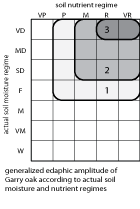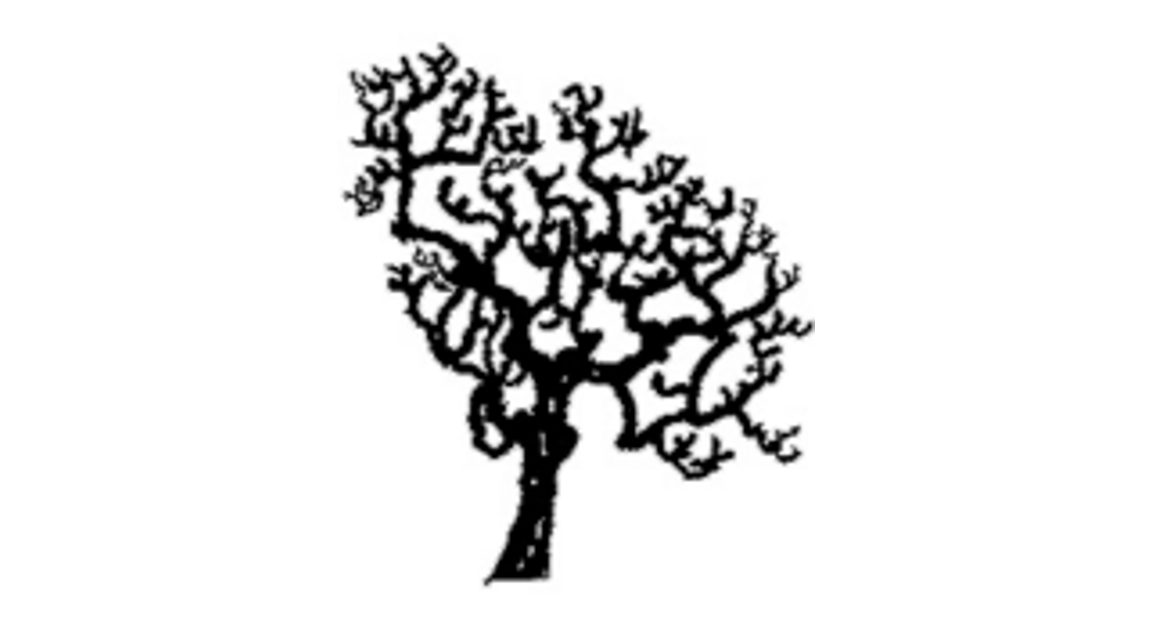Garry oak
Garry oak (Qg) - Quercus garryana
Garry oak is a tall shrub to small-sized, less often, medium-sized (<30m ) deciduous broad-leaved tree, at maturity with a broad rounded crown, short, stout, and often forked stem, numerous twisted, gnarled, branches, and dark, grayish-brown, scaly bark, with narrow shallow furrows.
Garry oak is not grown for timber production in our province. While Garry oak is not considered an endangered species in B.C., there are several ecological communities on the provincial Red List where Garry oak is a dominant tree species.
For more information about species and ecosystems at-risk in B.C., visit the BC Species and Ecosystem Explorer.
On this page
- Geographic range and ecological amplitudes
- Tolerances and damaging agents
- Silvical characteristics
- Genetics and notes
Geographic range and ecological amplitudes
Geographic range
Geographic element:
Western North American/mainly Pacific and less Cordilleran
Distribution in western North America:
Central and south in the Pacific region; (central) and south in the Cordilleran region
Ecological amplitudes
Climatic amplitude:
(warm temperate) - cool and warm mesothermal
Orographic amplitude:
submontane - montane
Occurrence in biogeoclimatic zones:
CDF
Edaphic amplitude

Range of soil moisture regimes:
very dry - moderately dry - slightly dry – (fresh)
Range of soil nutrient regimes:
(poor) - medium - rich - very rich
Based on field studies, Krajina (1969) concluded that soil melanization is more intensive in Garry oak ecosystems than in coniferous ecosystems. The uppermost, dark gray melanized soil horizon in the Garry oak ecosystems is only slightly acidic, and resembles prairie soils in colour, but with no calcification in the B horizon. Under these conditions there is active nitrification, as indicated by the frequent occurrence of Galium aparine L., Geranium molle L., and Dactylis glomerata L., understory species that require nitrate-N for their growth.
Garry oak appears to require large quantities of calcium, similar to bigleaf maple or black cottonwood, and deposits this element in its bark. This is why some calciphytic bryophytes may inhabit the bark of Garry oak trees.
Tolerance and damaging agents
Root system characteristics
Garry oak has a deep taproot and well-developed lateral roots, thus is very windfirm. Roots are associated with ecto- and endo-mycorrhizae.
| Tolerance to | Tolerance class | Comments |
|---|---|---|
| low light | M | moderately shade-tolerant in warm mesothermal climates |
| frost | L | not a concern in cool mesothermal climates |
| heat | H | frequent on warm and dry sites |
| water deficit | H | frequent on dry and warm sites |
| water surplus | H | tolerates flooding and a strongly fluctuating water table |
| nutrient (mainly N) deficiency | M | absent in acid, very poor soils; infrequent in poor soils |
| Damaging agent | Resistance class | Comments |
|---|---|---|
| snow | L | snowfall is very low in the CDF zone |
| wind | M | high winds will break boles and branches rather than uproot trees |
| Risk class | ||
|---|---|---|
| fire | L | fire-resistant, except in the early developmental stage |
| insect | L | not a serious concern |
| fungi | L | not a serious concern (root and butt rots) |
Associated tree species and successional role
In British Columbia, Garry oak grows in small, open-canopy stands or mixed-species stands, typically with common douglas, less often with Pacific madrone on warm-aspect, water-deficient sites on southeastern Vancouver Island and the Gulf Islands. It is present in early, mid-, and late stages of secondary succession and can be present as a minor or major component in old-growth stands on a few sites in the CDF zone.
Genetics and notes
Genetics
Though Garry oak populations in Oregon and Washington are disjunct and scattered, the chemical composition and morphological characteristics of their foliage are similar. Genetic differences appear to be minor. Garry oak hybridizes with Quercus dumosa Nutt., Q. douglasii Hook. and Arn., and Q. lobata Née.
Notes
Although not grown for timber production, scattered trees and open-canopy Garry oak stands are highly valued scenic assets in wildlands, parks, and urban areas. Feasibility of managing Garry oak stands for truffle production is being investigated. More detailed silvics information is given by:
Stein, W.I. 1990. Quercus garryana. Pp. 650-660 in R.M. Burns and B.H. Honkala (technical coordinators) Silvics of North America, Vol. 2. Agri. Handbook 654, USDA For. Serv., Washington, D.C.



